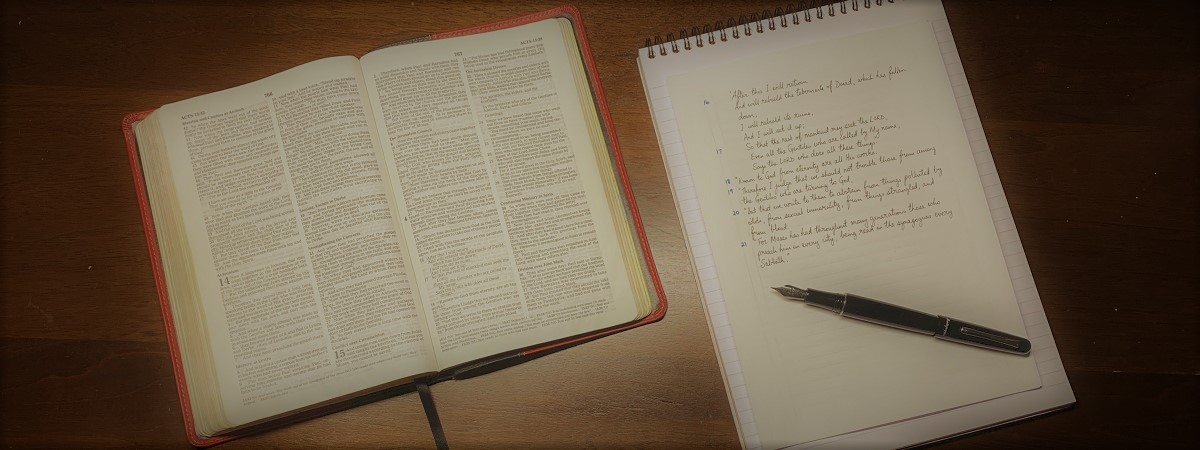
There are a number of things to consider if you want to choose equipment for handwriting the bible. I’m going to discuss it all in this post, and then explain my own choices at the end. But first, you should start by answering a few preliminary questions:
- Are you only interested in the process? That’s perfectly fine. Some people just want to experience the spiritual growth that can come from meditating on the words of Scripture as they copy them out. In that case, though, the equipment will be far less important. Just use any pen or pencil lying around the house, and any notepad or copy paper. Heck, write on the backs of old envelopes if you want to! It can be still a valuable exercise to do, but you can just throw your writing away after you’re finished. On the other hand …
- Do you plan to collect the scriptures you copy? If you think you might do this as a regular discipline, you could end up copying a lot of passages; potentially whole books, or even an entire copy of the Bible. You might regret having just thrown away all that fruit of your labor.
- How long do you want your writing to last? Some of us are intentional enough about handwriting the Bible that we’d like to preserve it for a long time. Imagine a handwritten copy that outlasts your lifetime. It can be passed to your children or grandchildren, with your own testimony written in the front. How might that speak to them of your faith? If that’s something you’d like to do, you’ll need to choose equipment for handwriting the Bible more carefully.
- Do you plan to copy Bible books in order? That decision will inform how you collect the writing. Which brings us to the first choice of equipment …
Table of Contents
1. Something to Write ON: Paper
There are a couple of obvious options. You can either write in books, or on separate pieces of paper. Both have pros and cons …
Using a Journal or Notebook
There are some really attractive journals you can buy, and the main advantage of this method is that it conveniently keeps all the pages neatly together. Which also makes it easier to continue writing if you have to travel; just throw your journal and pens in a bag, and off you go.
But there are some challenges with it too. What if you’re working on a complete Bible, but you don’t want to copy the books in their normal order? What if you make some mistakes along the way (and you will, I promise)? Are you happy to just cross the errors out and have that as part of your copy of the Bible forever?
One more issue to consider is that, with a few exceptions, notebook paper tends to be thicker. So you may need a lot of them, and quite a bit of shelf space, for a full Bible.
Using Loose Leaf Paper
This has been my own choice. I decided early on that I wanted to be able to work on books of the Bible individually, and in my own order (to coincide with my preaching series in church). But I still wanted to be working on eventually completing the whole Bible.
I wasn’t too concerned about writing when I’m traveling, but there were other important considerations for me. I wanted the paper as thin as possible, but also fountain pen friendly. That can be a challenge, because most thin paper will allow “bleeding” or “ghosting” of the ink. If it’s bad enough, only one side of the paper may be usable.
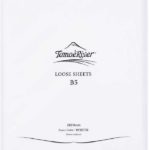
Fortunately, I knew just the solution …
Tamoe River Paper
Produced in Japan, Tamoe River is a coated paper beloved by the fountain pen community. It is super thin at only 52 gsm (grams per square meter). But it’s coating means that it does not absorb the ink, which is what causes feathering, bleeding through, or ghosting. Instead, the ink dries on top of the paper, retaining it’s intended color and sheen.
I called a local book binder and explained my project, and they confirmed that having it professionally bound at the end would be feasible, as long as I left enough margin around the edges. More about that later.
I chose “B5” as the size I thought would work best. That’s 6.93 x 9.84 inches. And I preferred white over cream.
2. Something to Write WITH: Pens
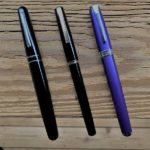
Again, there are lots of options, and many people will be just fine with a ballpoint. But you might prefer a smoother gel pen, a roller ball, a felt tip, or even a pencil (if you’re not worried about fading over time). And for those with a very artistic flair, you may be considering lots of “flourishes”, so the right choice to consider may be a calligraphy set.
My own choice should be no surprise. I’ve written elsewhere about my love of fountain pens, and I’ve given a bunch of reasons why I enjoy using them. But when you choose equipment for handwriting the Bible, you should consider that it’s a lengthy project (think in terms of several years at least). The fact is that fountain pens cause the least amount of hand strain, because you only need to press down very lightly.
3. Something to Preserve the Words: Ink
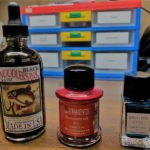
If you’re using a disposable pen, you’ll be limited to the colors that are available in the brand you choose. The good news is that there are more colors available now than ever before.
The great thing about using fountain pens is that you have endless ink options. Sometimes almost too many! You can drive yourself crazy trying to decide between two very similar shades.
A bigger question that you really should think through is durability. Do you need it to dry very quickly? Should it be waterproof? And how long do you want it to last?
Personally, dry time is not a huge concern for me, but I definitely want “archival quality” inks. The kind that last for years on the shelf without fading much at all.
I also want to stick closely to normal Bible color conventions. i.e. mostly black ink, with red for the words of Jesus, and a single decorative color for chapter headings and verse numbers.
4. Something to Copy From: a Bible
Again, there are few things to consider. You might, for instance, think about what size print you want to copy from. If you’re going to spend a lot of hours at it, and perhaps sometimes late at night or early in the morning, eye strain could become a factor.
Another thing that’s important is that the Bible you choose should lay flat on a table. Most Bibles do, especially those with a leather cover. But one that won’t lay flat (eg. a paperback) is not really suitable at all. It will drive you crazy to try and copy text from a book that keeps flipping shut!
And then the other thing you’ll have to decide is which Bible version you want to copy from. If you’re just making a copy of the Psalms, a poetic paraphrase may be a good choice. For an heirloom, perhaps you consider going back to the traditional King James Version? Or you might just prefer your favorite daily study version.
[Please Read My Post: Are There Copyright Issues With Making a Handwritten Bible?]
My own preference is the New King James Version which I have read daily for years.
So, let’s put all of that data together! Here’s …
My Chosen Equipment for Handwriting the Bible
[Click here to check out “My Handwritten Bible Starter Kit.”]
At the time of this writing, I’ve completed:
- The Gospel of Mark
- The Book of Judges
- The Book of Ruth
- The Gospel of Luke
- Half the Book of Acts
That’s given me plenty of opportunity to evaluate my choices, and I can tell you that I’m very happy with how it’s going.
So, here’s my setup:
My Bible
I’m using a New King James Version (Thomas Nelson Publishers), bound in calf leather with the words of Jesus in red print. It’s well worn in, so the pages turn easily, and it always lays perfectly flat on my desk. The font size is not very large, but I can read it quite comfortably.
Interesting side story … I bought this Bible in an emergency while I was traveling around India preaching, because I left my Bible on a plane. I arrived in Bangalore and had to preach that night, but with no English Bible at hand. So we quickly found a Christian bookstore, and I bought this one. Happily it has since turned out to be a favorite of mine. (And I’ve always wondered how God may have used that other Bible I left on the plane!)
My Paper
I’ve chosen to use Tomoe River FP (which stands for “fountain pen”). I buy it in B5 loose sheets (6.93 x 9.84 inches) in stark white. It comes 100 sheets to a pack.
[Click here to check out all my paper product recommendations.]
Paper and pen are obviously the most basic equipment for handwriting the Bible, and so must be chosen most carefully. Which brings us to …
My 3 Pens and Inks
For my Bible copying I’m using three different pens inked up with the three different colors that I’ve chosen. All three have nibs capable of writing a nice fine line to keep my lettering from getting too large.
- Montegrappa Elmo with a fine nib, inked up with Noodler’s Black. I use this for the bulk of the work.
- Sailor Young Profit (Samiko) with a 14k gold medium nib, inked up with De Atramentis Red Document Ink. I use this for the words of Jesus in the New Testament.
- Levenger True Writer with a fine nib, inked up with Pilot Iroshizuku Ama-Iro. I use this teal colored ink for chapter headings and verse numbers.
None are these are very expensive fountain pens. They are mid-range in price, the Elmo being the most expensive. All three are workhorses.
There are, however, cheaper options that you can consider and still have a wonderful writing experience. I highly recommend you consider getting yourself a couple of Pilot Metropolitans to begin with. They write beautifully, and are very inexpensive “starter” fountain pens.
[Click here to check out all my fountain pen recommendations.]
My Other Accessories
 I keep a couple of sheets of Herbin Blotting paper close at hand. When I’m finished writing a page, I’m ready to turn over and continue on the other side, but what I’ve just written may not be completely dry yet. So, I place the blotting paper down on the page and press. It absorbs (“blots”) any wet ink, so that it doesn’t smudge when I turn the page turn over.
I keep a couple of sheets of Herbin Blotting paper close at hand. When I’m finished writing a page, I’m ready to turn over and continue on the other side, but what I’ve just written may not be completely dry yet. So, I place the blotting paper down on the page and press. It absorbs (“blots”) any wet ink, so that it doesn’t smudge when I turn the page turn over.
And then finally … this is important if you’re using blank paper, as I do. I have designed and made my own “guide sheet”. I’m sure you know what I’m talking about. A guide sheet sits behind the sheet I’m writing on, and I can see it through the page. It provides:
- Horizontal lines to keep my writing straight
- Wide margins to keep me centered
- A vertical “column” on the left to guide the placement of verse numbers
[Click here to download my guide sheet if you’d like to use it!]
And that’s it!
Of course, my choices of equipment for handwriting the Bible are only one option. The set up you use will come down to personal preference and the goals that you’re trying to achieve.
But if you’re excited to get started on your own project, I’ve put together a shortcut to get you up and running quickly … Click here to check out “My Handwritten Bible Starter Kit.”
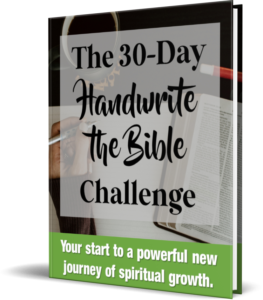 I hope I’ve given you some food for thought. I’d LOVE to know how others are approaching it. Leave a comment.
I hope I’ve given you some food for thought. I’d LOVE to know how others are approaching it. Leave a comment.
(By the way … have you taken the 30-Day Challenge yet? Download the free workbook.)
I began May 31, 2022, before seeing your post. I am using the Bible fast track reading plan found in the Names of God Bible which is 100 readings from Genesis to Revelation.
That’s great, Wanda! Thanks for sharing,
Phil
Thank you. I am looking to hand write our Father’s word as well. With the type of paper you chose can you write on both sides? And do you have a recommendation for how to put the book together so it will last? Like a soft binding book of sorts? God bless you.
Yes you can. I’m having mine professionally bound at a local book re-binder, but you could use a spiral binder, or even a 3-ring.
Phil
I recently started my scribing journey. I am using an interleaved journaling bible, ESV version. Every other page is blank. And yes, I do have to write, print, very small but I am thoroughly enjoying the journey! I am 65 and have 3 daughters. I would love to do one for each, but realize that may not happen.
Wonderful, T. Thanks for sharing – it encourages us all.
Phil
Is Tomoe River back? Or do you have a similar recommendation?
I have no new info. Sorry, Brenton. Whenever I find old stock somewhere, I try to buy it up. Can be pricey now.
Phil
Tomoe River as you know it is gone. The paper is now being produced by Sanzen under the Tomoe River name, but they haven’t been able to entirely replicate it. Most people say it is fine, but it isn’t the same. https://www.reddit.com/r/fountainpens/comments/1gx900t/current_status_of_tomoe_river_fp_paper/
That’s my understanding too, Brittany. Thanks.
Dear Phil, I was looking for a whole book 8×11 of traceable psalms. I am trying to grab the penmanship tool for when I am tired and I need a diversion from fanatical snacking. There seems to be a book available. This is a great idea except for my usual mistake ratio. I love the idea of this! I will suggest it in my newsletter.
This is amazing! How do you bind your pages? My mom wrote the entire Bible in three years. She is starting again after my dad passed last week after five years of battling cancer and I want to join her on this journey. Praying for healing as we grieve through this time.
Wow, way to go Mom!
I’m sure there are a bunch of ways to bind your manuscript – from 3 ring to spiral binders, and so on. But I contacted a local book re-binder who told me that, as long as I leave a good working margin, they should be able to bind my finished product professionally. It’s getting pretty hefty, though, so it may end up being 2 volumes!
Phil
So happy to have found this article, Pastor Phil. I thought I was crazy considering handwriting the entire Bible. That is likely still the case, however I can take joy and comfort that I am not alone. 😁
Thank you for all your tips!
Nancy
Thanks Nancy. I hope you really profit greatly from your project!
Phil